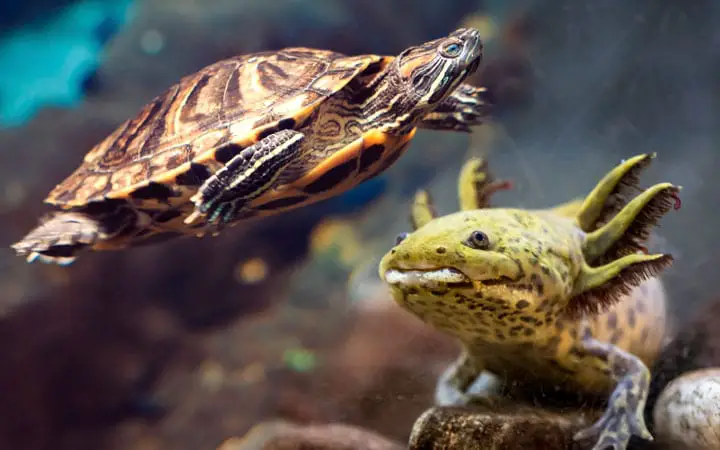When it comes to deciding whether reptiles and amphibians can live together in a single cage, a number of factors need to be taken into consideration. Most owners, however, do not recommend it. This article will discuss some of the reasons why.
Living Together?
Amphibians, such as toads, require having a moist substrate. This often includes potting soil, sand, mixed vermiculate, and others. This is useful in burrowing at daytime and keeping them moist. Being amphibians, it is very difficult if their skin completely dries out. They thrive well at room temperatures.
On the other hand, reptiles, such as iguanas, thrive best at a higher temperature gradient. They also love higher humidity than levels favorable for the amphibians. Since it is imperative for reptiles to have a large swimming area for both swimming and soaking in, it is possible that amphibians could hop in and possibly drown if they fail to get out again safely.
Bodily Substances
Certain amphibians, such as toads, possess a lot of toxins that are stored beneath their skin glands. This could prove to be irritating to the reptiles, just in case they come in contact with them. When handled or startled, the amphibians can also release toxins from their parotid glands, irritating the eyes and other mucus membranes of the reptile. It can also be irritating to them when ingested by mistake.
It could also be possible that reptiles and amphibians end up passing parasites between each other. If one of them is wild-caught, they can carry parasites coming from the prey items that they consume. Despite being unlikely, if the reptile comes in contact with the toadstools, there is also a chance that the reptile could also end up having the parasites. If you had your amphibians examined and even tested by a herp vet, and also dewormed if needed, it could also reduce a load of parasites, though it may not be safe to take some risks.
Difference in Dietary Requirements
Another reason why it is not advisable to house reptiles and amphibians together is that they have extremely different dietary and nutritional requirements. Most reptiles are herbivores, eating mainly fruits and vegetables. On the other hand, amphibians will eat almost any type of animal protein that moves around, including little lizards, mealworms, little amphibians, slugs, snails, and other insects. It could turn out to be quite problematic if you offer them different diets.
If you are currently keeping reptiles and amphibians together, time will soon come when they start showing signs of territoriality and aggression, unless you are placing them in a big habitat so that each of them can establish their own territory. As they continue to mature, it is often safest to provide them either with a huge habitat or provide them with separate quarters. Watch out for signs of bullying or hogging of food.
Factors to Consider
When making a decision, the following are some factors that need to be taken into consideration:
1. Size of the Cage
Underestimating the size of the cage is usually the most common mistake that is made by owners when keeping pets. Keep in mind that space is extremely important in multi-species settings, most importantly in setups that are specially designed for a single species.
It is also important that all of the animals inside the cage have enough room for them to establish their own territory, regulate their body temperature, hunt for food, and behave as normally as possible without experiencing the threat from other cage mates.
Standard aquarium sizes that can be purchased in the market are usually too small in order to accomplish this goal when multiple species are being housed together. At the same time, the low, and long rectangular shape of most of these aquariums are not ideal for amphibian and reptile tanks.
2. Possible Predation
It is an almost natural thing for captive carnivorous reptiles and amphibians to try eating anything that moves. This includes other reptiles and amphibians. The actual size of the prey that can fit in their mouth can often be surprising.
As a rule, you may want to keep different species together, provided that they are of the same size. It is also as important to realize that though cannibalism is almost impossible, even taboo, among humans, there are no limits when it comes to reptiles and amphibians. Even when keeping a similar species, they should be similar in size to avoid potential predation.
3. Conflict in Environment Requirements
It is very important to completely understand the different environmental conditions that different species need before keeping them. It is difficult to accommodate different environments in a single cage. If the environments required by different species do not match, it is best not to keep them together.
One important factor that should be given consideration is temperature. Reptiles, for example, should be given with a thermogradient (range of temperatures) environment from one side to the other. Most amphibians, on the other hand, are kept best with a similar temperature range.
It is usually challenging to provide these varying temperature requirements in a single cage, which may also make combining reptiles and amphibians difficult to do so successfully. The preferable humidity level among these animals is also important to consider. Species coming from arid areas should not be caged together from those coming from tropical locations.
On top of the humidity and temperature, the actual physical setup is also important. Certain species are actually aquatic, which means that they may need a large water area. At the same time, there are others that are completely terrestrial and may even drown in deep water. Certain species may also thrive well in deep soil substrate, while others are classified as arboreal, which means that they prefer climbing spots and perches. It is difficult to give them these difficult conditions in a single terrarium, especially with smaller cages.
4. Differences in Diet
Some reptiles and amphibians that are almost similar in size, and live in a similar type of environment, are generally not poisonous in captivity. They would do fine, presumably, when kept together. However, this is not the case all the time since they may also eat different food. Diet is one of the essential factors to be considered in order to maintain captive reptiles and amphibians effectively. Not all species, unfortunately, eat the same food. Those who may do usually do not eat the same sizes.
It is also as important to understand that not all amphibians and reptiles are equally equipped with the capacity to catch food. The stronger ones may end up bulling the weaker species while competing for food, which may result in death among the weaker species.
Exceptions and Recommendations
Of course, there are still some exceptions. In fact, certain species can be kept together. However, as a general rule, if you are not yet familiar with the requirements of each species, it may not be best to keep them together, or even attempt mixing them since you do not understand their requirements enough to do so. You may not even have the experience required to identify some common problems which may ultimately develop inside a multi-species cage. Rather, it is recommended that different species be separately kept for a period of time before attempting to house them together. This will give you enough time to observe their normal behavior and understand their care requirements.



